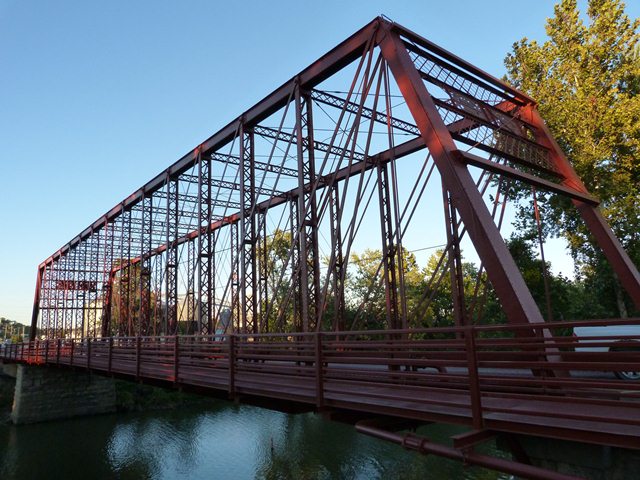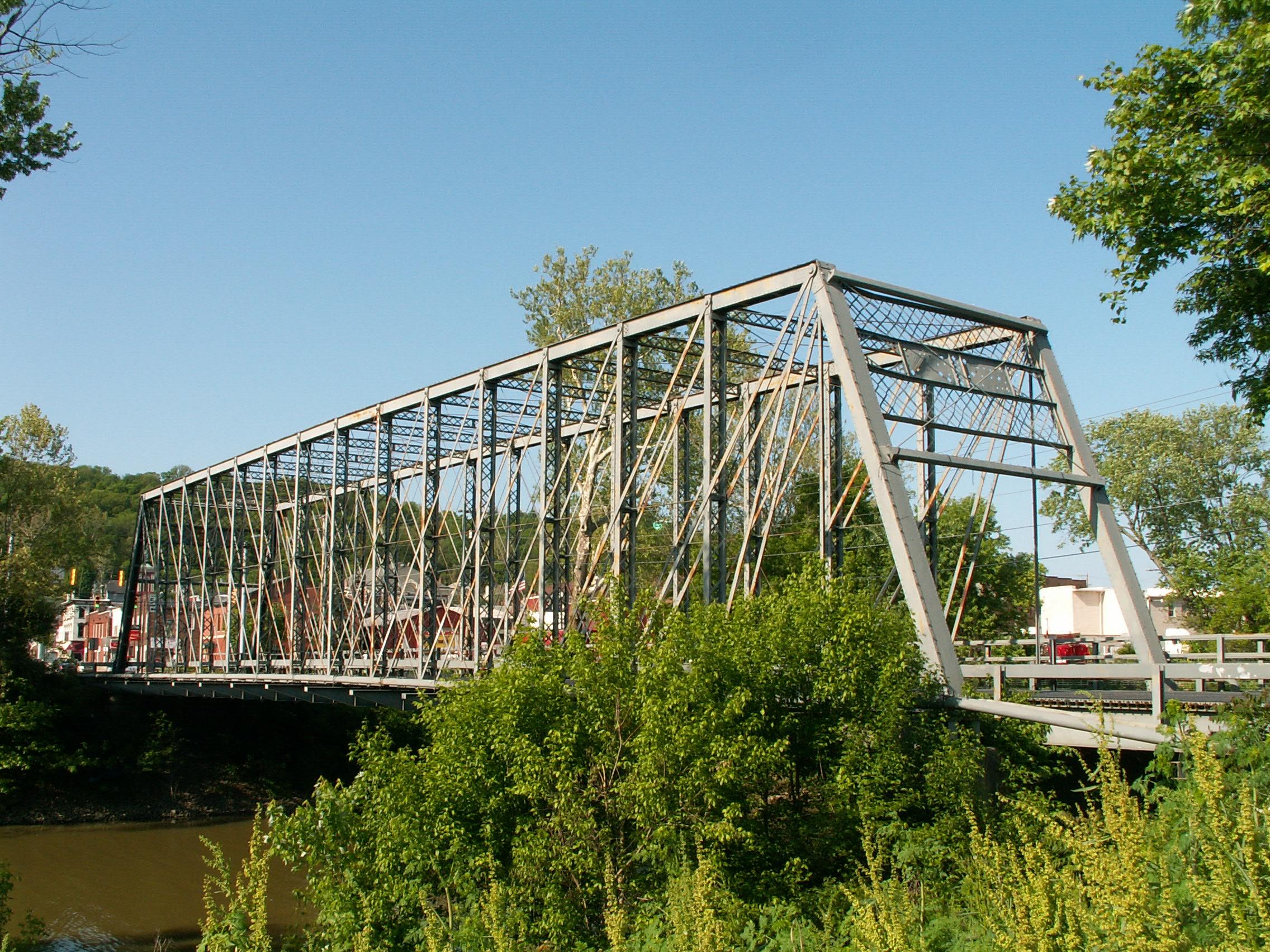We Recommend:
Bach Steel - Experts at historic truss bridge restoration.
George Street Bridge
Dearborn County Bridge 159

Primary Photographer(s): Nathan Holth
Bridge Documented: July 6, 2007
Aurora: Dearborn County, Indiana: United States
Metal 16 Panel Pin-Connected Whipple (Double-Intersection Pratt) Through Truss, Fixed and Approach Spans: Metal Stringer (Multi-Beam), Fixed
1887 By Builder/Contractor: Lomas Forge and Bridge Works of Cincinnati, Ohio
2011
200.0 Feet (61 Meters)
254.0 Feet (77.4 Meters)
23 Feet (7.01 Meters)
1 Main Span(s) and 1 Approach Span(s)
1500091

View Information About HSR Ratings
Bridge Documentation
View Archived National Bridge Inventory Report - Has Additional Details and Evaluation
View comments and discussion about this bridge's rehabilitations, capacity, analysis, and potential service life by engineer James Barker
2007 Observations
This bridge is a Whipple truss bridge, also known as the double-intersection Pratt truss. There are sixteen panels composing the bridge. The structure features pinned connections, and forms the centerpiece for the Aurora downtown area. It is nice to see a bridge being left standing for its aesthetic and historic value, and to bring interest to the downtown area of a small town. There is lattice on the sway bracing and v-lacing on the vertical members. The vertical members are unusual in that the channels that make up the built-up beams are they themselves built-up of plates and angles.
This bridge has undergone some major renovations that have allowed this beautiful structure to remain in use, at the expense of some historic integrity. Steel was welded onto the portal bracing, and the bottom chord was severed and reconnected with unusual turnbuckles. The flooring system was completely replaced, including the floor beams themselves. These were replaced with large beams that allowed pipes to be carried on one side, and a sidewalk to be added to the other. These losses to the historic integrity of the structure are rather dramatic, but on the other hand the bridge remains in use and remains a beautiful historic bridge.
The plaque on this bridge is mostly gone in a sense. The unusual plaque was made of a plate base, with the words fastened onto it. These words have since mostly fallen off.
Restoration Comments
In 2010, a high quality rehabilitation of this bridge was designed. Among the aspects of the work is the requirement that failed rivets be replaced with genuine hot-metal driven rivets, just like the bridge received when built in 1887. Typical highway rehabilitation projects replace failed rivets with historically incorrect modern high strength tension control bolts. Not only do these bolts look ugly (they lack a smooth heads on each end) they are alterations that diminish the historic integrity of the bridge. They are used because of the false believe that due to AASHTO and other regulations, the use of rivets in rehabilitation projects for bridges to carry vehicular traffic is forbidden. This is clearly not true, as the George Street Bridge proves.
Aside from other appropriate structural repairs, the project is also noteworthy because it will restore the damaged plaques to their original condition, rendering them both beautiful and legible.
This project was designed by J. A. Barker Engineering. HistoricBridges.org recommends this firm for any metal truss bridge rehabilitation project. Not only is the firm skilled in designing a project that will not reduce the historic integrity of the bridge, the project will be high quality so as to give a long service life, and will also be more cost effective than a firm that is inexperienced with historic bridges will offer.
Information and Findings From DHPA Historic Bridge SurveyStatement of Significance Having replaced a wooden truss, this is the Forge Bridge Company's only extant structure in Indiana. The George St. Bridge carried US Highway 50 until 1950 and SR 56 until 1972, connecting Aurora's southside with
its downtown. The structure retains most of its original members including its decoratively latticed portals and some of its latticed guardrail. Architectural Description The Forge Bridge Company of Cincinnati, Ohio, fabricated this unusual two-span 258'7" structure. The main span is a double-intersection Pratt (Whipple) through truss of 199'4", divided into sixteen panels with
intermediate verticals fabricated from angles riveted to plates and laced together. Cylindrical eyebars with turnbuckles serve two major functions: first; as a system to connect and stabilize the verticals at the horizontal
midpoint; second, as the central diagonals. A 56'3" Pratt deck truss of five panels approaches the Whipple from the east. With verticals composed of channels connected with stay plates and diagonals of rods with turnbuckles, the
approach span--like the main span--carries a steel grid deck with a 21'6" roadway and a sidewalk supported by girder floor beams U-bolted to pins. Other Information ALTERATIONS: Some guardrails missing. The steel grid deck replaced a wooden block deck in 1950. There is severe deterioration of the structural members of the deck truss. Bridge Considered Historic By Survey: Yes |
![]()
Photo Galleries and Videos: George Street Bridge
Bridge After 2010 Rehabilitation
Original / Full Size PhotosA collection of overview and detail photos. This gallery offers photos in the highest available resolution and file size in a touch-friendly popup viewer.
Alternatively, Browse Without Using Viewer
![]()
Bridge After 2010 Rehabilitation
Mobile Optimized PhotosA collection of overview and detail photos. This gallery features data-friendly, fast-loading photos in a touch-friendly popup viewer.
Alternatively, Browse Without Using Viewer
![]()
Bridge Before 2010 Rehabilitation
A collection of overview and detail photos. This photo gallery contains a combination of Original Size photos and Mobile Optimized photos in a touch-friendly popup viewer.Alternatively, Browse Without Using Viewer
![]()
Northbound Crossing
Full Motion VideoStreaming video of the bridge. Also includes a higher quality downloadable video for greater clarity or offline viewing.
![]()
Maps and Links: George Street Bridge
Coordinates (Latitude, Longitude):
Search For Additional Bridge Listings:
Bridgehunter.com: View listed bridges within 0.5 miles (0.8 kilometers) of this bridge.
Bridgehunter.com: View listed bridges within 10 miles (16 kilometers) of this bridge.
Additional Maps:
Google Streetview (If Available)
GeoHack (Additional Links and Coordinates)
Apple Maps (Via DuckDuckGo Search)
Apple Maps (Apple devices only)
Android: Open Location In Your Map or GPS App
Flickr Gallery (Find Nearby Photos)
Wikimedia Commons (Find Nearby Photos)
Directions Via Sygic For Android
Directions Via Sygic For iOS and Android Dolphin Browser
USGS National Map (United States Only)
Historical USGS Topo Maps (United States Only)
Historic Aerials (United States Only)
CalTopo Maps (United States Only)





